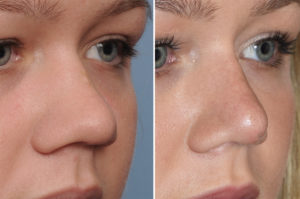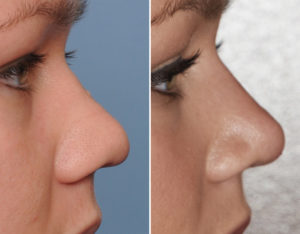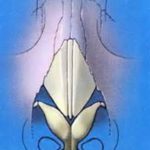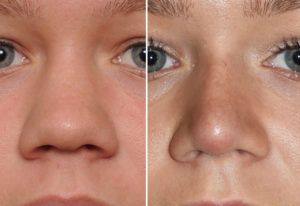Background: The tip of the nose is the most individual feature of one’s face. The size, shape and arrangement of the lower alar cartilages over the end of the septum create a wide array of end of the nose appearances. While each nasal tip can be said to be almost as unique as a fingerprint, multiple classifications of tip shapes have been described and categorized.
One broad category of nasal shapes is the wide nose. The wide nose always implies that the tip of the nose is broad and lacks a distinct tip shape. This is the result of the lower alar cartilages having an increased interdomal distance as well as an exaggerated intradomal distance. The nose tip usually lacks much recoil on pushing on it and will feel soft and spongy. The tip will have varying degrees of inadequate projection and may have shorter columella and wider nostrils as well.
Reshaping of the nasal tip lower alar cartilages is one of the most described techniques in all of rhinoplasty. Various forms of cephalic resections, suture reshaping methods and cartilage grafting of the columella and tip can be used. Determining and putting these nasal tip reshaping maneuvers together in any single patient to create the desired effect is an art form in and out itself.
Case Study: This 19 year-old female requested a rhinoplasty to change the shape of her nose. She was most bothered by her wide nasal tip that lacked refinement and made her face look flatter than what it really was.
Under general anesthesia she underwent an open rhinoplasty that included a small hump reduction, nasal bone osteotomies, cephalic trim of lower alar cartilages with double dome suture plication with a columellar strut made from septal cartilage harvest. Lateral crural sutures were also placed to create a supratip depression while also creating some tip rotation.


Highlights:
1) The width of the tip of the nose is controlled by the both the shape of the lower alar cartilages as well as their structural rigidity.
2) The wide nasal tip has large lower alar cartilages that has a flatter dome shape with increased interdomal distance.
3) Reshaping of the lower alar cartilages through an open rhinoplasty requires a combination of shape-changing sutures and a reinforced columella region onto which they can be secured and supported.
Dr. Barry Eppley
Indianapolis, Indiana




